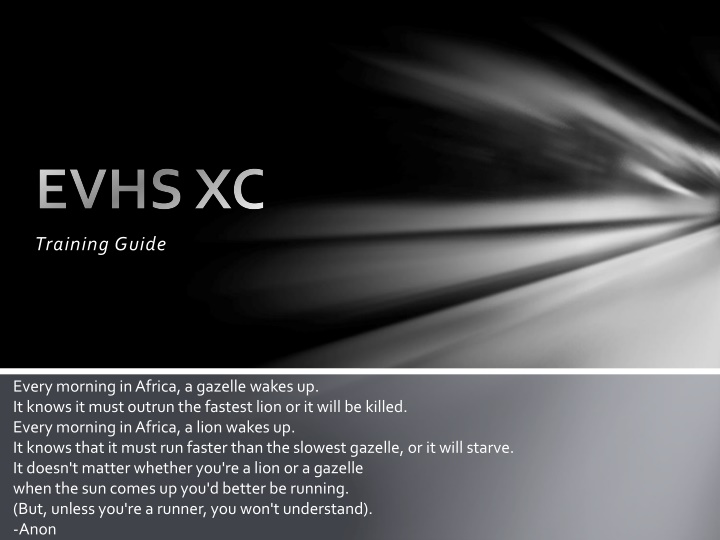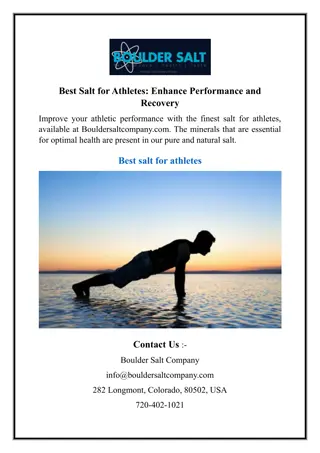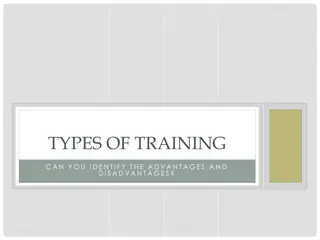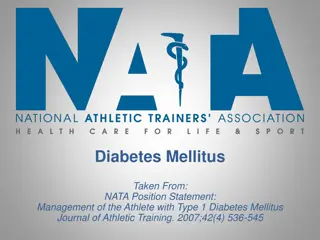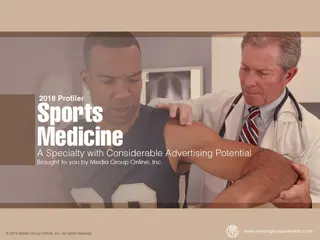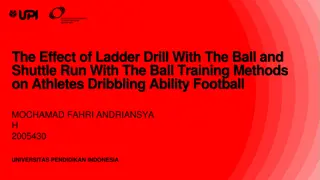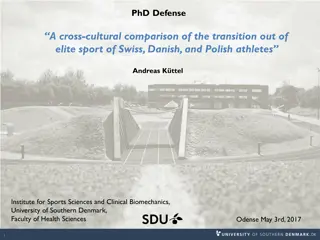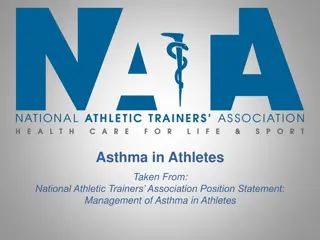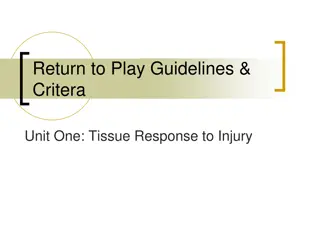Comprehensive XC Training Guide for Athletes
XC training guide covers various aspects of athlete preparation such as motivation, ability, training organization cycles, competition phases, and microcycles. Detailed insights into structuring workouts, preparation phases, and maximizing performance potential are provided.
Download Presentation

Please find below an Image/Link to download the presentation.
The content on the website is provided AS IS for your information and personal use only. It may not be sold, licensed, or shared on other websites without obtaining consent from the author.If you encounter any issues during the download, it is possible that the publisher has removed the file from their server.
You are allowed to download the files provided on this website for personal or commercial use, subject to the condition that they are used lawfully. All files are the property of their respective owners.
The content on the website is provided AS IS for your information and personal use only. It may not be sold, licensed, or shared on other websites without obtaining consent from the author.
E N D
Presentation Transcript
EVHS XC Training Guide Every morning in Africa, a gazelle wakes up. It knows it must outrun the fastest lion or it will be killed. Every morning in Africa, a lion wakes up. It knows that it must run faster than the slowest gazelle, or it will starve. It doesn't matter whether you're a lion or a gazelle when the sun comes up you'd better be running. (But, unless you're a runner, you won't understand). -Anon
4 Types of Athletes Who are you? Who will enjoy the most success? 1. Those with great motivation and great ability 2. Those with great motivation but less ability 3. Those with ability but lacking motivation 4. Those who lack ability and lack motivation To give anything less than your best is to sacrifice the gift. -Steve Prefontaine
Training - Organization It is the role of the coach to structure the season by devising and administering workouts at the various training intensities (as determined by race performances) so that an athlete is prepared to perform their best at the end of the competitive season.
Training Organization Cycles Macrocycle: Long period of training (4-6/9/12 mo. or one season) Mesocycle: Intermediate training block with a primary training emphasis (4-6 wks) Microcycle: Small period of training with specific goal (1-2 wks) Motorcycle
The Season Macrocycle Transition phase Preparation Phase Pre-Competition Phase Competition Phase Championship Phase Nike Regionals / Nationals
Competition Mesocycle If you fail to prepare, prepare to fail. pre Microcycle A: Primary Emphasis Intervals Secondary Emphasis Threshold Maintenance Running Economy Microcycle B: Primary Emphasis Intervals Secondary Emphasis Threshold Maintenance Running Economy Microcycle C: Primary Emphasis Threshold Secondary Emphasis Economy Maintenance Intervals
Microcycle Primary Emphasis Vo2 max (oxygen delivery) Secondary Emphasis Threshold (clear Lactate efficiently) Maintenance Running Economy / Speed
Training General Information Anaerobic doesn t use oxygen (Alactic or Glycolytic) Using stored chemicals in the muscles the body can generate energy for roughly 35-45 sec, Byproduct of this process is lactic acid in the muscles Eventually fuel source runs out and acidity level of muscles increases inhibiting energy creation (acidosis) Aerobic uses oxygen (Efficiency and Power) The body can produce virtually unlimited energy through chemical processes occurring in Mitochondria As you travel faster more energy is needed resulting in more acid accumulation; the mitochondria cannot clear this acid fast enough causing muscle contractions to become more difficult and you slow down
Training - Workouts Aerobic Running Threshold/Tempo Running Interval Running Repetition Running It takes 4-6 weeks of specific training for your body to adapt to the stresses placed on it from each emphasis of training. High school sports seasons are only 12 weeks long, For optimal performance preparation must begin in the off season.
Training Aerobic Runs Most important block of training (as long as possible) Effects Heart pumps more blood, decreasing heart rate Increases size, number, and efficiency of mitochondria (needed for aerobic training) Increased capillaries for oxygen delivery to muscles Intensity (conversation pace) 59%-84% Vo2 max 65%-90% HR max There is no increased benefit from training faster Duration Up to 25% of week s total volume Recovery Less than 24 hours Upper limits of these ranges are often referred to as anaerobic threshold or steady state runs
Training - Threshold Effects(improves endurance) 4 6 weeks Trains body to hold down blood-lactate accumulation and minimizes its effects allowing runner to run faster, longer. Intensity(24-30 sec slower than 5k race pace) 83%-88% Vo2 max 88%-92% HR max Pace at which mitochondria produces lactate faster than body s ability to clear it Duration 5 min (multiple efforts) 60 min (single effort) Recovery 24 hours Little rest No rest
Training - Intervals Aerobic Power/VO2 Max Effects 4 6 weeks Improves oxygen delivery and processing thus improving one s aerobic capacity Intensity(comfortably hard, not all out!) 95% - 100% Vo2 max 98% - 100% HR max Duration 3-5 min run with 1:1 or less recovery Recovery 48 hours
Training Alactic or Glycolytic Alactic = Fly s- max effort, Glycolytic = speed Effects Improve speed and economy, run faster while expending the least possible amount of energy Intensity Race pace or faster 105% - 120% Vo2 max Hills are an excellent form of strength training Duration Maximum 2 min with 1:1 rest or greater Recovery 24 72 hours (depending on intensity) 2 -4 weeks
Training Tables
Training - Strength Increased strength will help prevent injuries by allowing muscles to handle the forces applied to them the through running action While running you land with 2-3 times your body weight for each step. This multiplied by the number of steps you take in a typical run is a lot of weight Increased muscular strength attained through lifting and body weight exercises (core) will improve one s running efficiency and power You will cover a given distance with less effort
Training - Agility Increases coordination and flexibility This allows body to avoid injuries of overstressing/activating muscles Increased neuromuscular coordination attained through plyometric activities will also improve one s running efficiency and power You will cover a given distance with less effort
Training - Mentality Focus Enjoy the process, not the result The only way you can improve performance, is by increasing your training volume and/or intensity (working harder than the other guy, even if that other guy was you yesterday) Improvement takes time, celebrate the small successes along the way Be patient And above all else: BE CONSISTENT!
Training - Breaks It only takes 10-14 days to have a measurable loss in fitness It takes up to three times as long to regain a level of fitness, as it took to lose it Bottom line: BE CONSISTENT, it takes longer to make up missed time (and it hurts more) than maintaining a base level of fitness all year
Racing What we do today, we do better than yesterday, to be prepared for tomorrow
Racing "It's rude to count people as you pass them. Out loud." -Adidas ad Goal #1: Improvement Whether you are here to win a state championship or are here because you are not somewhere else, this is how we measure success The way we most often measure improvement is by race time If you are here, your coaches will use every trick in the book to see you improve, i.e. run faster
Racing Mentality Mind is everything; muscle pieces of rubber. All that I am, I am because of my mind. -Paavo Nurmi Racing is 90% mental, 10% physical Do not be afraid of success, do not shirk hard work, do not doubt what you are capable of Anxiety is normal and good, the release of chemicals heightens your awareness and provides blockers to pain receptors Fear causes tense muscles and the unnecessary waste of energy it holds you back!
Be Positive Do not be Afraid of Success, Do not Shirk Hard Work, Do not Doubt what you are Capable of Dream great Dreams Expect and Accept the Pain Achieve the unachievable
Racing - Mentality Run like hell and get the agony over with. --Clarence DeMar When running you are voluntarily breaking down your muscles, depleting your stored fuel, and stressing your body beyond the point of a normal day s activity. You are either the lion or the gazelle, but you are running for your life Its supposed to hurt!
Racing - Strategies "Cross Country Finally, a practical use for golf courses." Even pacing Optimal racing strategy. Start at the same pace you finish at. Need to know course markers and split times, difficult to execute Negative Splitting Next best strategy. Delays onset of fatigue NO JV KICK! If you can sprint the last 100m you could have sprinted the last 150m and why did you wait so long to start running hard! Use what you ve got for the whole race, not just when you think it looks good. Dying Starting too fast, having acidosis set in, being unable to race hard in the later stages of the race which is mentally defeating The only thing you can do at the beginning of a race is lose
Nutrition Carbohydrates are needed for their glycogen which fuels ATP (energy) generation in mitochondria. Should be 55-70% of diet Protein has amino acids that are necessary to rebuild muscles (smallest portion of diet) Fruits and vegetables have vitamins and minerals that support chemical processes in the body, great as snack foods Foods with iron, which prevents anemia, are especially important Water provides homeostasis for chemical breakdown to occur in mitochondria, which creates more energy, which keeps you less tired. Also, helps you stay cool and keeps the body at a temperature for chemical reactions to safely take place. Sip continuously throughout the day (water bottle).
Sleep The only time your body rebuilds muscles is during stages 3 and 4 of NREM Need 8-10 hours of sleep a night to give body a chance to complete enough sleep cycles to be ready for the next day. With less sleep your brain doesn t reboot and your muscles don t get rebuilt, you drain yourself An increase in your resting heart rate is an indication you aren t getting enough recovery If you need to get up at 6am to complete a 2-3 mile morning run, what time do you go to bed?
Equipment Watch Running shorts Running Shoes Spikes / Flats
Common Running Injuries You ll hear these terms when buying your training shoes. Here is what they mean.
Common Running Injuries Rolling an ankle keep moving on it, this prevents blood from pooling Side aches breathe in through your nose, out through your mouth. Pain will go away in 5-10 mins. Knee pains Causes Growth spurt Tight muscles, poor form, excessive impact Shin Splints pain in the shin when running Causes Tight muscles, poor form, excessive impact If untreated can develop into stress fracture
Injury Prevention Regular exercises and strength work to correct underdeveloped and imbalanced muscles such as calf raises, core, circuits Special exercises like toe scrunches, and leg lifts Icing / Ice bath (8 12 min) Rest / decreased work load
EVHS CC History JV Conference: Team has finished 1st, 2nd, or 3rd 16/18 years Varsity: Team has finished with academic gold standard every year of competition Team was 7th in state in 2000, 5th in 2007 & 8th in 2011 Individual Accomplishments Team Accomplishments Record book
How do you know if your child is a runner You need a magnifying glass to see their name in the paper. They have chafing in strange places. All their socks are either stained or torn. They can run farther in a week than their bus travels for meets. They use phrases like "10 mile" and "easy run" in the same breath. They can eat their weight in pasta. Their meals involve more than 3 servings. They schedule their dates around meets. You spend more on training clothes than school clothes. Your Christmas list includes more than one pair of running shoes. You feel lost without a water bottle in your hand. Your Saturday mornings for the rest of your life are ruined. You can see your child's ribs through their shirt. Your child gets turned on when they see a hill coming. Their favorite food group is carbohydrates.
How do you know if your child is a runner Your child foams at the mouth. You can sharpen an axe blade on their calves. You can wash clothes on their stomach They can maintain a 5:30 pace while throwing up. They own spandex in more than one color. "Chariots of Fire" is actually entertaining to you. Your child's watch is more expensive than their car. They know as many names for pain as Eskimos know words for snow. They don't know what an off-season means. They have 3% or less body fat. Their off-season ends a week after State. Your cookie jar is filled with bagels. You often hear people screaming, "Run, Forrest, run!" at your child. They can pronounce Kenyan names
EVHS XC Training Guide
